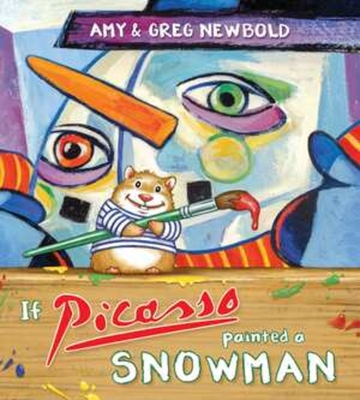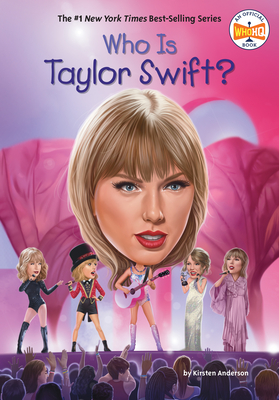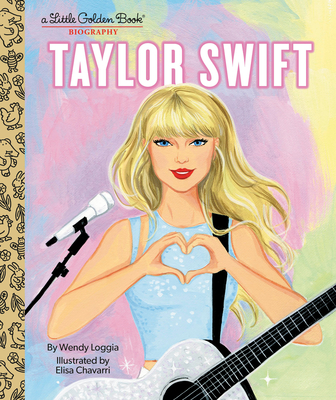
If Picasso Painted a Snowman (The Reimagined Masterpiece Series)
Description
Maryland Blue Crab Honor Book 2018
A big, brightly colored, playful introduction to various important painters and art movements.
If someone asked you to paint a snowman, you would probably start with three white circles stacked one upon another. Then you would add black dots for eyes, an orange triangle for a nose, and a black dotted smile. But if Picasso painted a snowman…
From that simple premise flows this delightful, whimsical, educational picture book that shows how the artist’s imagination can summon magic from a prosaic subject. Greg Newbold’s chameleon-like artistry shows us Roy Lichtenstein’s snow hero saving the day, Georgia O’Keefe’s snowman blooming in the desert, Claude Monet’s snowmen among haystacks, Grant Wood’s American Gothic snowman, Jackson Pollock’s snowman in ten thousand splats, Salvador Dali’s snowmen dripping like melty cheese, and snowmen as they might have been rendered by J. M. W. Turner, Gustav Klimt, Paul Klee, Marc Chagall, Georges Seurat, Pablita Velarde, Piet Mondrian, Sonia Delaunay, Jacob Lawrence, and Vincent van Gogh. Our guide for this tour is a lively hamster who—also chameleon-like—sports a Dali mustache on one spread, a Van Gogh ear bandage on the next.
“What would your snowman look like?” the book asks, and then offers a page with a picture frame for a child to fill in. Backmatter thumbnail biographies of the artists complete this highly original tour of the creative imagination that will delight adults as well as children.
Fountas & Pinnell Level O
Praise for If Picasso Painted a Snowman (The Reimagined Masterpiece Series)
With big, brightly colored original illustrations that range from evocative to downright authentic-looking, the Newbolds introduce 17 “modern” (more or less) painters by suggesting how each might have depicted a snowman. A smiling hamster wielding a paintbrush conducts viewers through a gallery that begins with a cubist “Picasso,” looks back to a vague shape in a Turneresque blizzard, and then darts in no particular order from Lichtenstein and O’Keeffe to Klimt, Pollock, Van Gogh (where the hamster acquires a bandage on its ear), Sonia Delaunay, and, finally, Grant Wood, with a version of American Gothic. Captions identify each artist, and appended biographical sketches add further information. For the most part, the artists make up a familiar roster of dead, white, male Europeans or Americans, and an inviting blank canvas at the end may prompt some would-be Picassos to draw directly on the page. Still, along with introductions to some significant figures in art history, readers will come away with clear notions of their characteristic styles, as well as visual differences between schools of art.
— John Peters - Booklist
Lynn: Most of us, if asked to paint a snowman, would start with three circles, then add a few details. But Amy and Greg Newbold ask what a snowman would look like in the hands of famous painters. If Picasso Painted a Snowman (2017) is their delightful answer. A chubby little hamster takes readers through a series of snowman pictures, all painted in the styles of iconic artists, from Picasso to Jackson Pollack. Vibrant, imaginative, and playful, this charming book is an art history survey course in a picture book. Newbold has done a terrific job using images and concepts kids can easily grasp to demonstrate the individual styles of 17 artists. The back matter is just as well done as the illustrations. Short biographies of each artist focus on their style. Greg Newbold’s Advice for Artists adds three wonderful tips for young aspiring artists. And a section called “Meet the Artists” notes that none featured in the book actually painted a snowman. I loved all the illustrations here, so choosing a favorite would be almost impossible. I’m currently wavering between Gustav Klimt’s and Van Gogh’s examples. How about you?
Cindy: I don’t know, Lynn. I like your choices a lot, but Roy Lichtenstein’s comic snowman sure packs a wallop. BLAM! As I write my part of this post on a particularly difficult morning, I feel a lot like the surreal snowmen in the Salvador Dali version. Here’s how Amy describes their riff on melting clocks in Dali’s famous painting The Persistence of Memory: In Salvador Dali’s winter fantasy, snowmen drip like melty cheese. The hamster’s Dali-esque curved mustache is the pièce de résistance! (And just one example of rodent humor on display.) My very favorite spread, though, might be one with a blank canvas propped on an easel with an encouragement to copy the page and make your own snowman. This is a ready-made art lesson for readers of any age. I want to get out my paints and create my own. Kids will, too. This book is sure to sell in art museum gift shops, but make sure your library or classroom or child or grandchild has one too...and some art supplies!
— Cindy Dobrez and Lynn Rutan - Booklist Reader
This book was such a treat! Not only did it have an example of how
Picasso may have depicted a snowman, it also had examples of how many
other well-known artists such as Van Gogh and Monet would have painted
their snowmen as well. If you’re a fan of the arts, or have seen many
famous paintings, the beautiful illustrations in this book will
certainly look familiar to you. This is a great book to introduce kids
to the different styles of various famous artists. It’s perfect for
little aspiring artists, and a treat for older ones!
— Shifa - Children's Book Council Staff Picks
There are short ones and tall ones and fat ones and skinny ones. All sorts of items, natural and man-made are added to further distinguish their physical characteristics. Just as there are no two snowflakes alike, there are no two snowwomen, snowmen, snow children or snow creatures alike. Each one is as unique as its maker.
An exploratory adventure begins when an unseen narrator says: But if Pablo Picasso painted a snowman it would look like . . . A page turn reveals the rather satisfied hamster holding a paint brush covered in red paint with a tube of red paint spilling out next to him. On the opposite page is a snowman portrayed in the style known as Cubism. Elements are rearranged and removed. Excitement follows page by page. Within a murky haze we are asked to find a single snowman. A superhero snowman comic-book style swings a fist as a loud BLAM! in red letters explodes on the canvas. A stark desert landscape hosts a snowman with a skull and antlers for a head and a lush floral array in its center. Can you identify the three artists?
A brightly colored quilt wraps around a snow family. Haystacks stand with snowmen like sentries. Pablita Velarde's birds keep company with her snowman. Is there a snowman hidden in the Jackson Pollack splatters? No one can fail to recognize the painter who might have depicted snowmen languishing like wet noodles on an alien plain or the two snow people standing in front of buildings straight out of Americana, the one holding a shovel upright. With each revelation our knowledge grows.
Artist Greg Newbold through meticulous research replicates the techniques and styles of each of the seventeen painters focusing on those most notable works. Some of his illustrations span a single page, edge to edge. Others appear as a large portion of an artist's canvas. Several cover two pages crossing the gutter. Two are placed playfully with overlapping corners, as if waiting to be hung on a wall.
Art educators and those interested in art are going to be thrilled with If Picasso Painted a Snowman written by Amy Newbold with illustrations by Greg Newbold. In fact, even those who don't believe they like art will enjoy this book. The premise of using a snowman, in which most can identify, to present the artists is a marvelous idea. On the final two pages, the hamster invites you to paint your own picture on a page showing a blank easel you can replicate. The next six pages give more information about the artists. As a final note Greg gives artists three key points of advice. It might be fun to ask students to research other artists and create snowmen as they would. If you are doing a Mock Caldecott unit, you might feature snowmen as drawn by Caldecott artists. This title would be a welcome addition in your professional and personal book collections.
— Xena's Mom - Librarian's Quest
...
This a wonderful book! Many of the readers of MC have kids
or are aunts and uncles. This book is for you and yours. It is a great
introduction to a large variety of artists and their work, but also opens up
the imagination to all the possibilities of different artists paint, but also
how different thinkers might approach the same challenge.
— Howard Lyon - Muddycolors.blogspot
The Newbolds use the example of a snowman to drive home the idea that “not all artists paint the same.” With a cherubic hamster as guide, who wields paintbrushes and mugs for readers, Amy Newbold imagines how 17 famous artists might have painted a snowman, giving her husband a chance to try out each artist’s style. A large snowman cuddles two smaller ones, all wrapped up in a quilted blanket, in a Klimt-inspired spread; in a remake of Dalí’s The Persistence of Memory, flattened snowmen replace drooping clocks. Newbold keeps the text short and punchy (“Blam! Roy Lichtenstein’s snow hero saves the day!”), and she covers a range of artistic styles, from Monet’s impressionism to Klee’s abstract art and the “flat” images of Pueblo artist Pablita Velarde. A blank easel invites readers to contribute their own snowmen, and the book concludes with capsule biographies of the featured painters. The hamster’s antics can be a bit much (he’s shown with a bandage over a missing ear on the Van Gogh page), but in all it’s an inviting introduction to a range of important painters. Ages 6–12. (Oct.)
— Publishers Weekly
Did you ever wonder how Vincent van Gogh would paint a snowman? Or how Georgia O’Keeffe might depict the frozen subject? This book shows the reader how 17 well-known artists might illustrate this particular subject matter. The story begins with the simple way most know: draw three circles, add the eyes, triangle shaped nose, and a dotted smile. Then things become interesting. A snowman shape is incorporated into a famous artist’s painting or one is created in his/her style. Instead of melting clocks, as in Salvador Dalí’s painting, we see liquefied snowmen. There is a pointillism snowman in the style of Georges Seurat, and you’ll never look at Grant Wood’s American Gothic painting the same again. The artwork is excellent as the illustrator captures the artist’s style perfectly. The slight amount of text is just enough to engage young readers. A small hamster is the guide throughout. He dons a beret, mustache, or a bandaged ear (a tribute to van Gogh). The hamster may not be on every page, but when he is present, he adds humor. The end of the book includes information about the artists named and a bit about their individual styles of art.
VERDICT An excellent way to introduce children to classic artists and their styles. It also might encourage budding artists to think outside the box and create images in their own unique style
— School Library Journal Express
A range of art styles is explored in this picture book that invites readers to imagine how various artists would paint a snowman...The examples of the art mimic some of the artists' famous paintings but incorporate imagined snowmen into them. For example, Dali's "snowmen drip like melted cheese" in a double-page spread that emulates "The Persistence of Memory" with flattened, drooping snowmen rather than timepieces depicted on the surreal landscape...A closing spread with a blank easel nicely invites readers to copy it and make their own snowman painting. Endnotes provide further context about the artists...A playful introduction to various art movements...
— Kirkus


